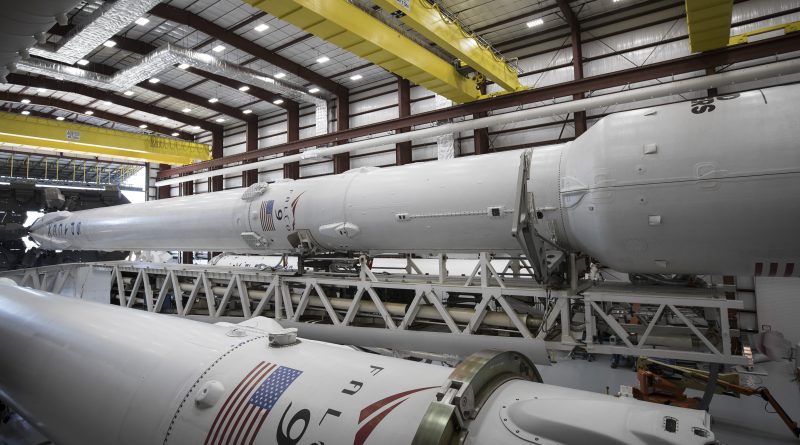After Tight Launch Flow, Falcon 9 Counts Down to Momentous Re-Flight Mission
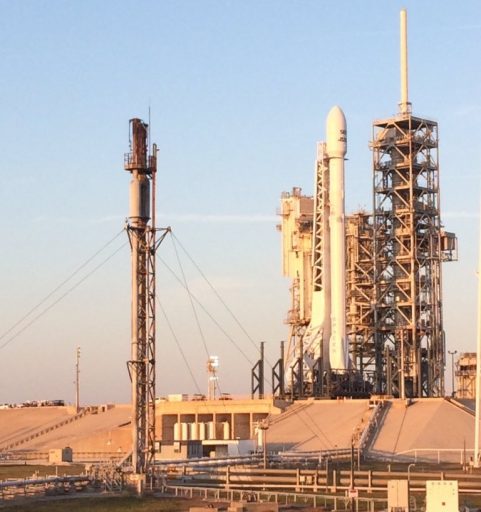
SpaceX is counting down to the first re-flight mission of the company’s Falcon 9 rocket to mark another milestone on the path to achieving regular re-use of first stage boosters to drastically reduce the cost of delivering satellites to orbit.
Having helped lift a Dragon spacecraft into orbit last year, the first stage of the Falcon 9 rocket aims to repeat its trip to the edge of space and back Thursday night, lifting a commercial communications satellite into orbit.
After a tight launch flow, Falcon 9 is aiming for liftoff at 22:27 UTC on Thursday, 6:27 p.m. local time at Florida’s Space Coast, the opening of a two-and-a-half-hour launch window. The first stage will be in action for a little over two and a half minutes for its primary task before the MVac-powered second stage takes over for a pair of engine burns to send SES-10 into a highly elliptical Geostationary Transfer Orbit 32 minutes after launch. Ideally, the first stage will return after just eight and a half minutes for a landing on the Autonomous Spaceport Drone Ship – a landing attempt classed as another hot re-entry.
Thursday’s re-flight has been years in the making. Elon Musk founded SpaceX in 2002 with the ultimate goal of colonizing Mars and reusable launch vehicles were deemed a necessary technological step on a path to sending humans to the Red Planet.
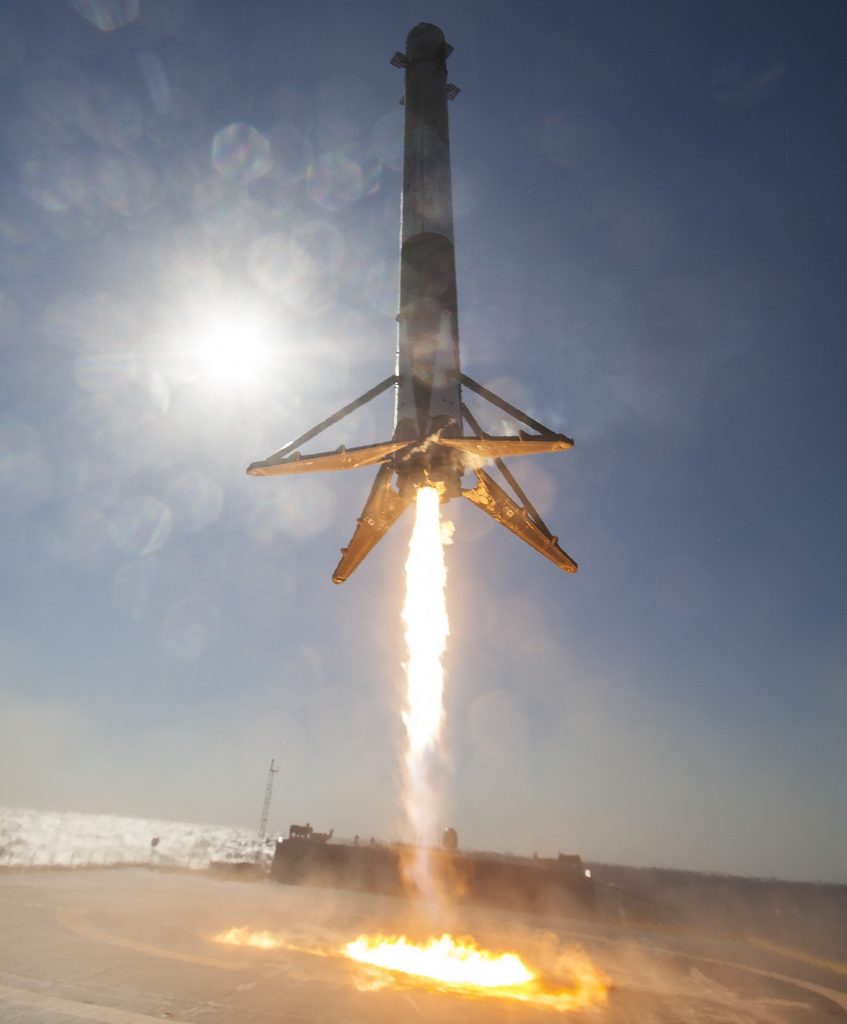
Reusability for SpaceX’s Falcon 9 rocket was first discussed in 2009 and detailed concepts were made public in 2011. Since then, SpaceX has been making strides in demonstrating the principles of rocket reusability – starting out with increasingly high flights of the Grasshopper & F9R Dev test vehicles to explore the low-velocity regime of the landing while boosters flying operational missions demonstrated they could survive re-entry and maneuver toward a precise landing point in the Ocean. Eventually, SpaceX had built up enough confidence to position the company’s Autonomous Spaceport Drone Ship downrange from the launch site to provide a floating landing pad for the Falcon 9 boosters.
SpaceX recovered its first rocket in December 2015 with a spectacular powered on-shore landing at Cape Canaveral’s Landing Zone-1. The drone ship landings proved out much harder to master and it took several months of fine-tuning before the “Of Course I Still Love You” could return its first Falcon 9 booster to port in April 2016.
The only step missing to fully demonstrate SpaceX’s re-usability paradigm is the actual re-flight of a recovered booster in an orbital mission.
Launching rockets is always risky business and SpaceX is entering previously unknown territory, eventually aiming to re-fly rocket stages several dozen times. As the first re-use mission, Thursday’s flight takes on a pathfinder role, but despite being the first re-flight of its kind, the mission will attempt to carry an operational satellite into orbit.
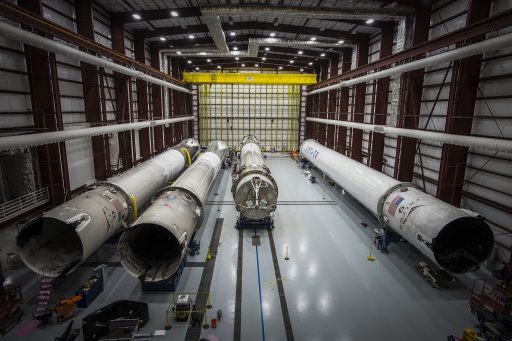
Satellite operator SES announced last August that the company had committed to becoming the first customer on a Falcon 9 re-use mission. According to SES CEO Martin Halliwell, insurers have not increased their premiums for the re-flight mission vs. an all-new rocket as SpaceX had demonstrated through months of inspections, refurbishment and reviews that the Falcon 9 first stage was in pristine condition and ready to handle the trip to space again.
Since its first trip to space on April 8, 2016 on the Dragon SpX-8 mission, the first stage underwent around four months of refurbishment work, being partially taken apart for detailed inspections. Despite the partial disassembly, the stage remains in its original configuration for Thursday’s mission, sporting the same Merlin 1D engines that powered it into space last year.
After refurbishment, the booster completed a full-duration fire test at SpaceX’s Texas facility and, on Monday, the assembled Falcon 9 rocket underwent the standard pre-flight Static Fire Test. Falcon 9 then returned to its hangar to receive the encapsulated SES-10 payload ahead of rolling out to Launch Complex 39A late on Wednesday to enter its vertical launch position for 13 hours of payload checks after installation ahead of pressing into final countdown operations.
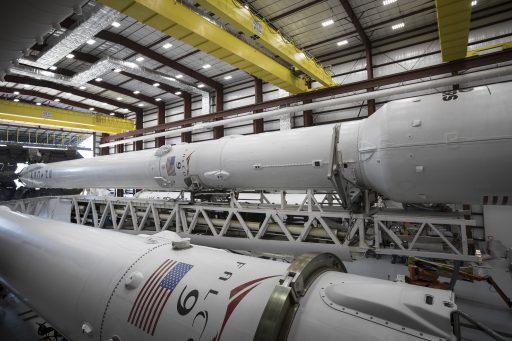
Thursday’s launch comes nearly one year after the booster flew for the first time. Eventually, SpaceX plans to ready flown vehicles for re-use in a period of days, however, the company expects it will take several years to streamline the turnaround process, also requiring Falcon 9 to upgrade to its Block 5 version that incorporates a number of features to make refurbishment less time and money-consuming.
Initially, SpaceX is offering around a 10% discount to customers willing to fly on used boosters but future cost reduction is envisioned to be around a third once boosters are regularly re-flown. Out of its inventory of eight boosters, SpaceX said up to six are in a condition to allow re-flight as early as this year if a customer can be found.
SES said the discount did not affect their decision that was classed as a strategic move to get the first proof-of-concept mission off the ground to demonstrate SpaceX can safely re-fly rocket stages. The Luxembourg-based satellite operator has a long history of opting for new launch vehicles, becoming the first commercial customer to launch a satellite on Russia’s Proton rocket back in the 1990s and placing a satellite on SpaceX’s first mission to Geostationary Transfer Orbit back in 2013.
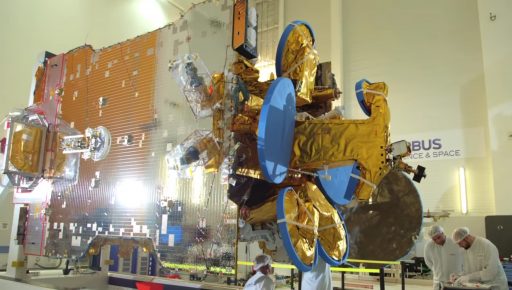
If Thursday’s mission is successful, Martin Halliwell said SES may opt to launch two more satellites, SES 14 and 16, on “flight-proven” rockets later this year. SES-11, penciled in for liftoff this summer, is booked on a brand new Falcon 9 rocket. SpaceX’s government customers, NASA and the U.S. Air Force, are not yet willing to fly on used boosters and will require full re-certification if opting for a re-use mission in the future.
The SES-10 satellite sitting atop the Falcon 9 on Thursday weighs in at 5,289 Kilograms – taking the rocket right up to its maximum capacity for a drone ship recovery and creating a very hot re-entry. SES-10, built by Airbus Defence and Space in Europe, will replace a pair of satellites launched in the late 1990s and enable SES to offer Ultra-HD television services to Mexico, South and Central America as well as the Caribbean via 50 high-power Ku-Band transponders. The satellite is considered an important part of the expansion of SES satellite services into UHD markets.
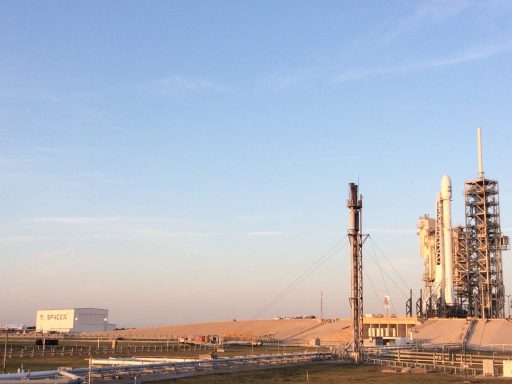
Thursday’s countdown operation will get underway with the activation of the Falcon 9 rocket for a multi-hour checkout campaign while SES-10 finishes its final testing operations and fully charges its batteries. The Falcon 9 countdown is designed to finish all launch vehicle checks prior to the L-90 minute mark to clear the way for an expedited propellant loading sequence given the rocket’s use of densified propellants.
Meteorologists are predicting 80% odds of favorable weather conditions for Thursday’s window, the only concerns being cumulus and thick clouds. The 2.5-hour window duration will give the launch team some margin to deal with technical issues or wait for a break in clouds should it be required.
Propellant loading will be preceded by a poll of the Launch Team at L-78 minutes before the automatic countdown sequencer kicks in at the T-70 minute mark. At that point, both stages of the rocket enter Rocket Propellant 1 tanking, receiving around 155 metric tons of the -7°C fuel. Concurrently, final chilldown on the oxidizer tanks will begin before Stage 1 enters LOX load at T-45 minutes followed at T-30 minutes by the second stage; Falcon 9 receives a total of ~360 metric tons of the -207°C oxidizer.
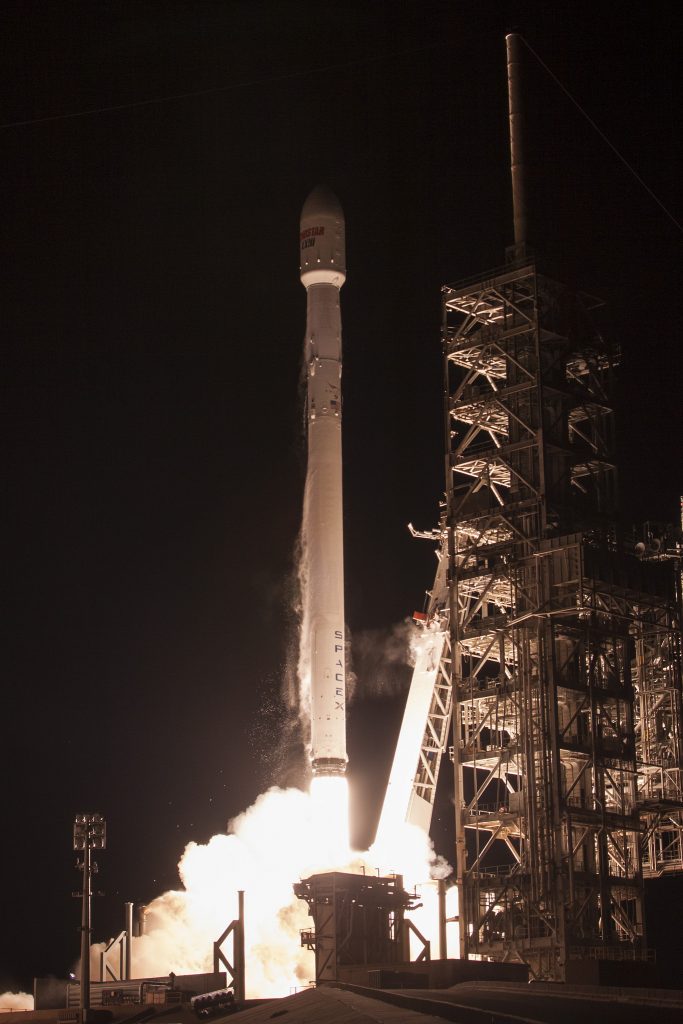
Propellant loading will be in full swing until T-3 minutes and Falcon 9 will also receive Helium acting as tank pressurant gas and Nitrogen that powers the cold gas thrusters on both stages. SES-10 will transfer to battery power in the last half hour of the count and the pace of countdown events will pick up noticeably at the T-7-minute mark when Falcon 9 begins chilling down its nine Merlin 1D engines for ignition. The vehicle will then transition to battery power, exercise its various engine valves, arm the Flight Termination System and assume full control of the count at the T-1 minute mark for the pressurization of tanks.
Falcon 9 will soar to life at T-3 seconds as all nine Merlin engines fire up to reach a collective liftoff thrust of nearly 700 metric ton-force to lift the 70-meter tall rocket off the ground. Clearing the tower of Launch Complex 39A, Falcon 9 will climb vertically before pitching and rolling onto a south-easterly departure path to take the standard route to Geostationary Transfer Orbit.
Burning nearly 2,500 Kilograms of propellants each second, Falcon 9 will accelerate beyond the speed of sound in just over one minute followed by the area of maximum dynamic pressure at T+82 seconds for which the booster will throttle back briefly. The first stage will continue firing until T+2 minutes and 38 seconds, leaving only the bare essentials in terms of propellant reserves for the return to Earth.
Three seconds after MECO, pneumatic pushers will separate the stages and send the booster clear of the MVac engine of the second stage that will ignite eight seconds after staging to continue powering SES-10 into orbit. Separating at a speed in excess of six times the speed of sound, the first stage will immediately pulse its cold gas thrusters to enter the turn to a tail-first position. Given the marginal propellant reserves of this mission, the first stage will not make a boost back maneuver and remain on a ballistic arc until close to re-entry.
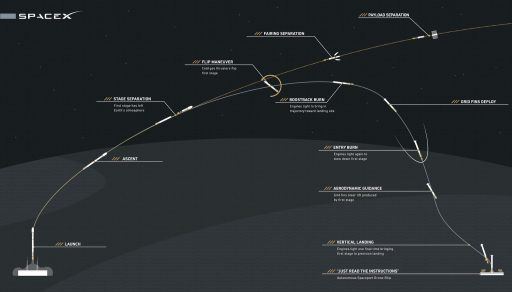
The first stage will re-light a subset of its engines at T+6 minutes and 19 seconds to slow down for re-entry and shield the engine section from the most extreme entry environment. Through lessons learned from the first hot-entry experiences, SpaceX developed techniques for the first stage to protect its engines on the way down, enabling it to deal with more extreme environments.
After the half-minute entry burn, the booster will rely on its four actuated grid fins to fly out any errors in along- and cross-track to precisely home in on the location of the ‘Of Course I Still Love You’ Drone ship that will be holding position 550 Kilometers downrange from the launch site. While descending through the atmosphere, the booster will pass through the sound barrier in the reverse direction ahead of firing up on its landing burn eight minutes into the mission.
The 47-meter booster is hoped to enter a vertical descent toward the drone ship’s deck with the engine throttling heavily to set the first stage down on its four landing legs at T+8:32.
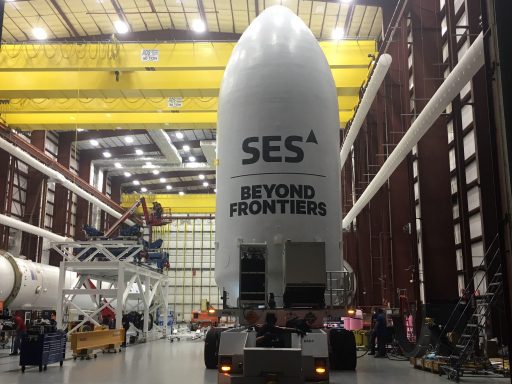
Getting the booster back a second time would not only mark a major achievement for SpaceX but also give them invaluable data on how the hardware fares during repeat missions. However, given the tight propellant margin and re-entry energy, the success of the landing is not a certainty and although it is not the prime objective of the mission will most likely have the attention of everyone not directly involved in the mission.
Supporting the primary objective of the day’s mission, the second stage will start out by making a five-minute and 45-second burn with its 95,000-Kilogram-force MVac engine to push the stack into a Low Earth Parking Orbit. Three minutes and 49 seconds into the flight, the 13-meter long fairing halves will split open and fall away from the ascending rocket to shed no-longer-needed weight and reveal the SES-10 satellite.
Just as the first stage’s journey reaches its dramatic conclusion, the second stage will safe its Flight Termination System and head into Terminal Guidance mode ahead of shutting down just shy of the T+9-minute mark. Next will be a coast phase of 18 minutes to allow the second stage to continue its south-easterly trek across the Atlantic and re-light the engine when passing the equator so that the high point of the injection orbit is placed above the equator on the opposite side of the planet – standard procedure for GTO insertions.
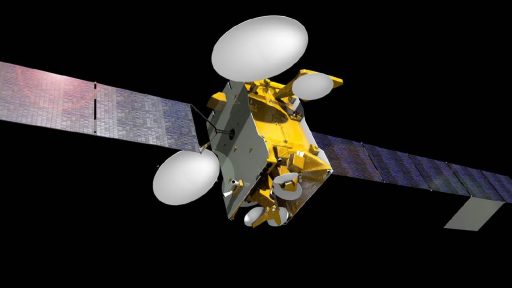
The critical second burn of the MVac engine is expected to commence 26 minutes and 29 seconds into the flight and last 53 seconds with some heavy throttling toward the end as the second stage gets lighter and lighter. SES-10 is aiming for an orbit of 218 by 35,400 Kilometers at an inclination of 26.2 degrees with the spring-loaded separation of the satellite expected at T+32 minutes and three seconds to mark mission success for the 32nd Falcon 9 mission.
From its highly-elliptical drop-off point, SES-10 will complete the transition into Geostationary Orbit over the course of April to reach its intended orbital position at 67 degrees West in Geostationary Orbit where the satellite’s velocity matches that of the Earth’s rotation. The satellite is expected to become operational in mid-May, marking the start of a 15-year mission supporting Ultra High Definition TV distribution, enterprise services and broadband connectivity.

